‘We Go, So the World Sees.’ Why Journalists are Necessary in the War Zone

The campaign to discredit journalists and provoke hatred towards journalists has been promoted on the Internet recently – ‘everybody lies,’ they say.
Ukrayinska Pravda.Life talked to several media professionals about their missions, experiences, toughest challenges during the last two years, and why they continue working against all the odds.
Max LEVIN, LB.ua photographer
During last two years, Max had a lot of missions to the war zone and broadcasted Maidan events non-stop. He is one of the four Ukrainian journalists who were extricated from Ilovaisk in August 2014.
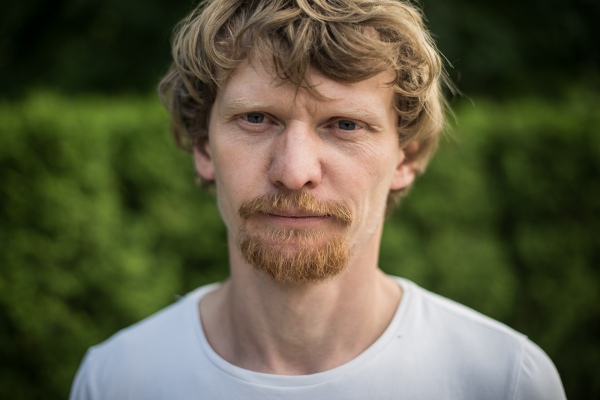 |
| Max Levin, LB.ua photographer, had many missions to the war zone during the last two years |
When I was extricated from the besiegement in August 2014, I used to report ‘adrenaline’ dependence from the war. But I never reported that people ‘are not afraid.’ Everyone is afraid, including me.
Every time I go there, I make farewells to my wife and children as if it could be the last time. Why is it important to go there? Just one example: approximately one year ago, numerous museums started to approach me requesting my photos of the 2014-2015 events, as it has already become history. Some 10-15 colleagues used to go there earlier, now there are fewer, less than ten.
People in Ukraine believe that there is no war there, foreigners tend to think that everything is clear. So — we go, so the world sees. Nobody is concerned with the war now, but it will be useful for history.
The most difficult job is to explain to myself what I want to say with my photos so that it is interesting for both Ukrainians and foreigners.
I can understand why it is important for Ukrainians — 3-5 people die there every day. But why do foreigners need it?
How to present it in a way that everyone is interested and donors give grants so that we can continue recording? In any way, we need money for these missions.
Recently, I started taking photos of civilians, war victims, displaced persons, while servicemen recede in the background since last summer.
The UN and other international organizations are more concerned with it, because it is a humanitarian conflict, not just military. People often have no access to food and water there. Displaced people are out of a job ‘trapped’ in their camps. It is something that foreigners are concerned with.
Kateryna SERGATSKOVA, Hromadske TV reporter
During the war in Donbas in 2014 she was one of the few Ukrainian journalists who were able to cover the conflict from both sides. In March 2015, she published a book "The War in Three Letters" co-authored by Artem Chapai and Volodymyr Maksakov. Originally a Russian citizen, in April 2015 she received Ukrainian citizenship.
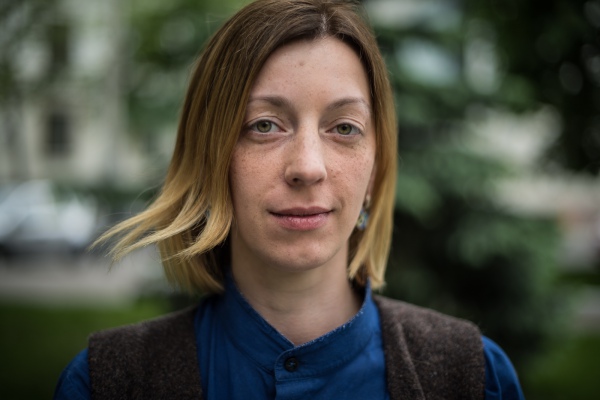 |
| Kateryna Sergatskova, Hromadske TV reporter, one of the few Ukrainian journalists who were able to cover conflict from both sides |
…After they tried so hard to discredit us, it is very difficult to regain trust and respect. In general, journalists don’t enjoy a high level of trust – some 20%. People tend to trust volunteers – like those who created the website ‘Myrotvorets’ [Ukr.: The Peace-Maker].
In fact, a lot of media professionals are dishonest. Many TV channels belong to businessmen and oligarchs who lobby their own interests through the mass media. But journalists of independent media outlets suffer the most.
Publication of personal data of journalists on the ‘Myrotvorets’ website reminded me of my experience of going to the war zone. May 11, 2014, was an alarm bell. On that day, a ‘referendum’ was organized to support the ‘Donetsk People’s Republic’ (DNR). We arrived to Krasnoarmiisk on the day when Ukrainian forces killed two local residents, as they came too close to them.
When I reported it, the Facebook community exploded: "How can you write about it, it is nothing more than Russian propaganda." It was psychologically hard for me – not because of this pressure, but because I witnessed death with my own eyes. It was totally unexpected for me – I personally knew some soldiers from this military unit. And nobody believed us, even other Ukrainian media professionals. ‘It is impossible,’ they said.
The Interior Ministry refuted this information. Later on, in private talks, they recognized the killings did happen. But they could not disclose it publicly, because it would entail responsibility.
Our best way to counter propaganda is to provide a true, reliable account of developments. While reporting the conflict in Donbas, I came to an understanding: any bullet has someone who shot it.
There is the Russian propaganda that tries to persuade anyone: "There is no truth, everybody lies. You’ll never get the truth, because everybody shoots and everybody commits crimes." Actually, it is not the case. In any crime, there is a perpetrator.
When we investigate it, we’ll learn who started the conflict. There will be the one to blame.
People tend not to consume information critically. That’s why they believe the ‘Myrotvorets’ website that alleges: every journalist accredited with Russia is a criminal, as he or she cooperates with terrorists. It is absolutely necessary to shift this paradigm, better late than never.
When it comes to the work on both sides of contact line. Sure, we can abstain from visiting Donetsk and Luhansk – but then, we’ll never learn how people live there, what are their concerns and needs. We’ll never learn that food products are scarce there, that people die from a lack of insulin. I personally know such cases. We go to the occupied territories to hear civilians who live there not because they want to, but because they have no other options.
If we care about these people, we have to go there and cover their real life.
Roman MALKO, cameraman and photographer
In December 2013 he was a journalist of state-run UT-1 TV Channel. He publicly blamed his management for censorship and disseminating false information about the Maidan events and resigned.
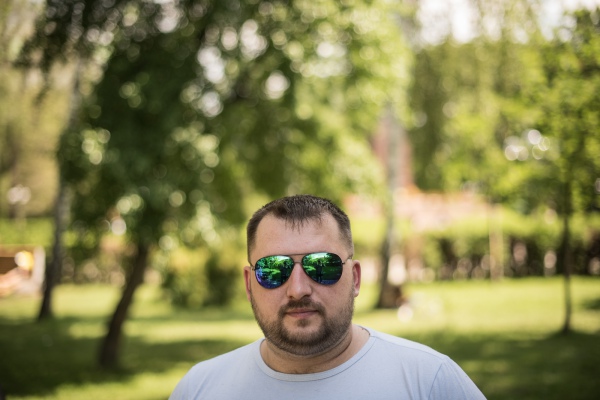 |
| Roman Malko, cameraman and photographer, publicly blamed the UT-1 management for censorship and disseminating false information about the Maidan events |
I went to the war zone by myself, because many people refused, and I had military experience – I knew what I can face there.
The most challenging there was to see how young men die – those who had no experience but who wanted to protect their families, children.
Many servicemen opposed journalists, because the latter could accidentally reveal their positions to militants. So, we were aware that someone could die because of our negligence, and we tried to be careful.
I can’t go to the occupied territory any more, because I am on the ‘banned list’ of Russian proxies. From now on, I’m also on the list of ‘our side.’
I always keep in touch with my colleagues who visit the war zone. Many of them are unhappy that their personal details were disclosed. Moreover, this list contains even persons who have never been to the war zone…
Anastasia Vlasova, photojournalist
Anastasia had dozens of missions to war areas. She visited the occupied Crimea and was covering the Maidan events. When shooting in Donetsk, she was detained by militants and survived ‘tough’ interrogation, allegedly by the Russian FSB.
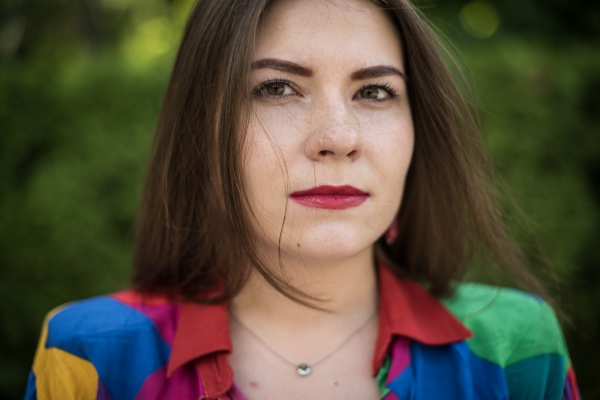 |
| Anastasia Vlasova, photojournalist, had dozens of missions to war areas, and visited the occupied Crimea |
I can’t recall any breaking point when I said to myself that I am going to the war zone. It happened smoothly and at the same time very quickly: Maidan, Crimea… So, I didn’t even consider whether I have to go to Donbas.
We were working on both sides – during the fights for Sloviansk, Luhansk. By that time, there was no ‘Ukrainian accreditation.’ I have a vivid recollection of a moment when I noticed our soldiers, equipment, tanks in some village in Luhansk oblast. I started shooting them immediately, and they instantly told me that taking photos was not allowed and that we had to call their press-office. Inspired, we went back and started calling them. We had the feeling that we should not be afraid of anything when communicating with the Ukrainian military.
I remember a day in Sloviansk when I was walking down the street with a camera on my neck. Some uniformed men approached me. I plunged my hands into the pockets, like I was just walking – it was too late to hide my camera. They started searching and interrogating me, looking my notes and shots. Nothing serious, but you don’t feel comfortable in that environment of fear and stress.
I would say it’s more comfortable to work on the frontline rather than in Donetsk downtown, with all these people looking at you. They can always check your ID, search you. It’s always stress.
We wanted to go there, because a journalist has to present both sides of the conflict. It is a matter of the quality of your product.
If foreigners watch our materials, they would ask: "why are all your materials, photos, quotations only from one side?"
Some colleagues say me: ‘Well, it’s easier for you, cause you are woman. You can start flirting, and they’ll let you go," but that’s sexism. Everybody has his or her strengths or weaknesses.
My last time in the war zone was in January – I went there to cover the Red Cross mission.
I still remember my experience in Debaltseve in February 2015, when all checkpoints were closed the very next day after the Ukrainian military were extricated from the besiegement. People could not even reach the neighboring village of Myronivske.
All the journalists who stayed there understood that a lot of civilians remained trapped. They had to go by foot for several days to flee the area of Debaltseve. Journalists in Artemivsk witnessed and recorded it. It was not such a beautiful operation as President Poroshenko said. People were calling for health care for several days: ‘My legs are injured, come take me out of here.’
I believe access was banned for journalists so that they could not learn of such situations.
Piotr ANDRUSIECZKO, journalist of Gazeta Wyborcza (Warsaw), editor-in-chief of Ukrainian Journal (Prague)
One of the first to provide live information from Sloviansk as the city was captured by militants. He stayed there until he was warned that he was on a ‘blacklist.’
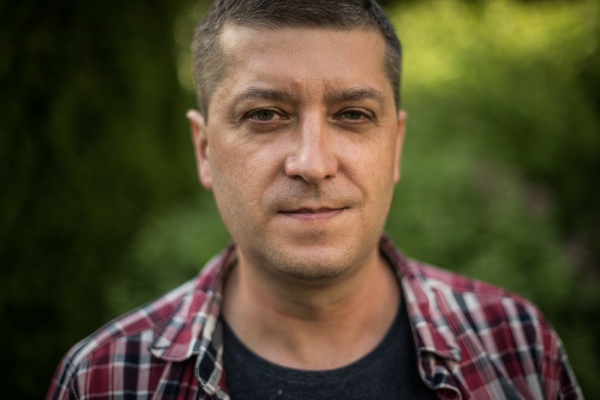 |
| Piotr Andrusieczko, journalist of Gazeta Wyborcza (Warsaw), editor-in-chief of Ukrainian Journal (Prague), one of the first to provide live information from Sloviansk as the city was captured by militants |
It’s impossible not to go to the war zone. If you are a journalist covering Ukrainian topics, you have to be in the hotspots. In fact, the high-profile developments went non-stop in Ukraine during 2013-2015. We kept going there to talk to people and know what was going on there.
We follow this conflict for more than two years and look for new topics, in the humanitarian sector in particular - how people cope with all these challenges, how their life has changed. Sure, the military action is ongoing, but average people’s lives are also interesting.
It was extremely difficult when I arrived to the place of the Malaysian aircraft crash. The very environment, uniformed people all around me, the heat… It’s as heavy as lead, but you should stay calm, look around and record it. Moreover, you should keep ethical issues in mind – what media could show, and what not.
Another tough moment was in fall 2014, when I found a cache in Donetsk outskirts where some 40‑50 persons had lived under shelling for four months, including young children, elderly. They had no complaints against me – as it often happens – they just wanted me to report that they are there.
It’s important for me to go to Crimea. The Ministry of Information Policy is trying to ease the access to Crimea from Ukraine’s mainland for foreign journalists, but it depends on the Migration Service rather than on the Ministry.
When it comes to eastern Ukraine, I got an impression that journalists are banned from accessing these territories. I remember the statements of several politicians as of late 2014, ‘you journalists should not be allowed there.’
Anton SKYBA, media producer
Born in Donbas, Anton was a CNN fixer in the war zone. He was detained by the ‘DNR’ from July 22-26, 2014.
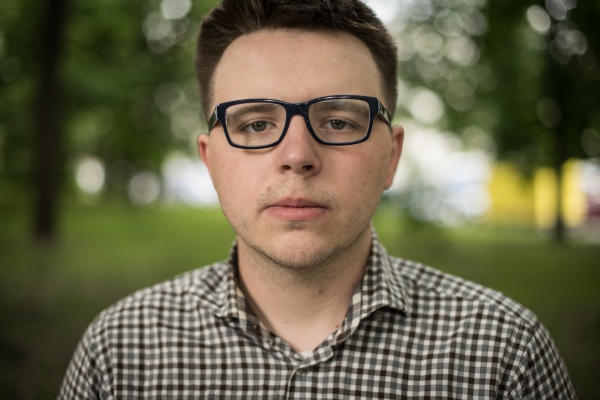 |
| Anton Skyba, media producer, worked in the war zone and was held by the militants |
I was not directly engaged in journalism when I was going to the war zone and before it. I mostly helped foreign journalists – as a fixer, interpreter and then as a producer. My personal mission was to stay alive and to provide security to my colleagues – as much as I could.
I had to provide their secure entry to the Government-controlled territory after they had worked in the occupied areas, to provide them with access ‘to the field’, and to smooth the bumps that could emerge.
And I had to work impartially and double-check all the facts. We had a rule: if you have any doubts about a certain fact, you don’t report it. It’s better to double-check everything than to provide false information.
The MH17 aircraft crash was one of the most raw moments of my life. We were one of the first to arrive there. French journalists noticed this crash and went there immediately, and we followed them. The so-called ‘DNR’ representatives kept walking around and saying ‘Holy shit, what we did!’
It was also clear at that moment that something strange was happening, and it was critically important to get as many journalists there as possible.
We used all possible and impossible tricks, we invited journalists there even if they lacked so-called accreditation. We just brought them to the field so that they could report this major evil to the entire world.
My last story was for the Canadian The Globe and Mail.
We used the help of foreign journalists to rescue a pro-Ukrainian activist whose Twitter was followed by some 20,000 subscribers from the non-controlled territory. The militants arrested, beat him, took his ID and detained him for a long time. It was extremely important to get there and rescue him.
If a government or some other actor tries to cover itself from the public, it has something to hide. Therefore, something illegal happens there.
Actors who do the right things do not cover themselves from journalists. They are open, transparent, and they are ready to bear responsibility for their actions.
Actually, responsibility entails openness.
Photo and video by Oleksii Furman. Text by Roman Kabachiy, Institute of Mass Information. Translated by Mykhailo Koriukalov
Nota Bene! Publications of the English version of Ukrayinska Pravda are not verbatim translations of the source publications from the Ukrainian or Russian language versions of our website. For the sake of clarity and editorial effectiveness our translators might take the liberty of shortening and retelling parts of the source publications. Please consult the text of original publication or the English editorial staff of Ukrayinska Pravda prior to quoting our English translations.